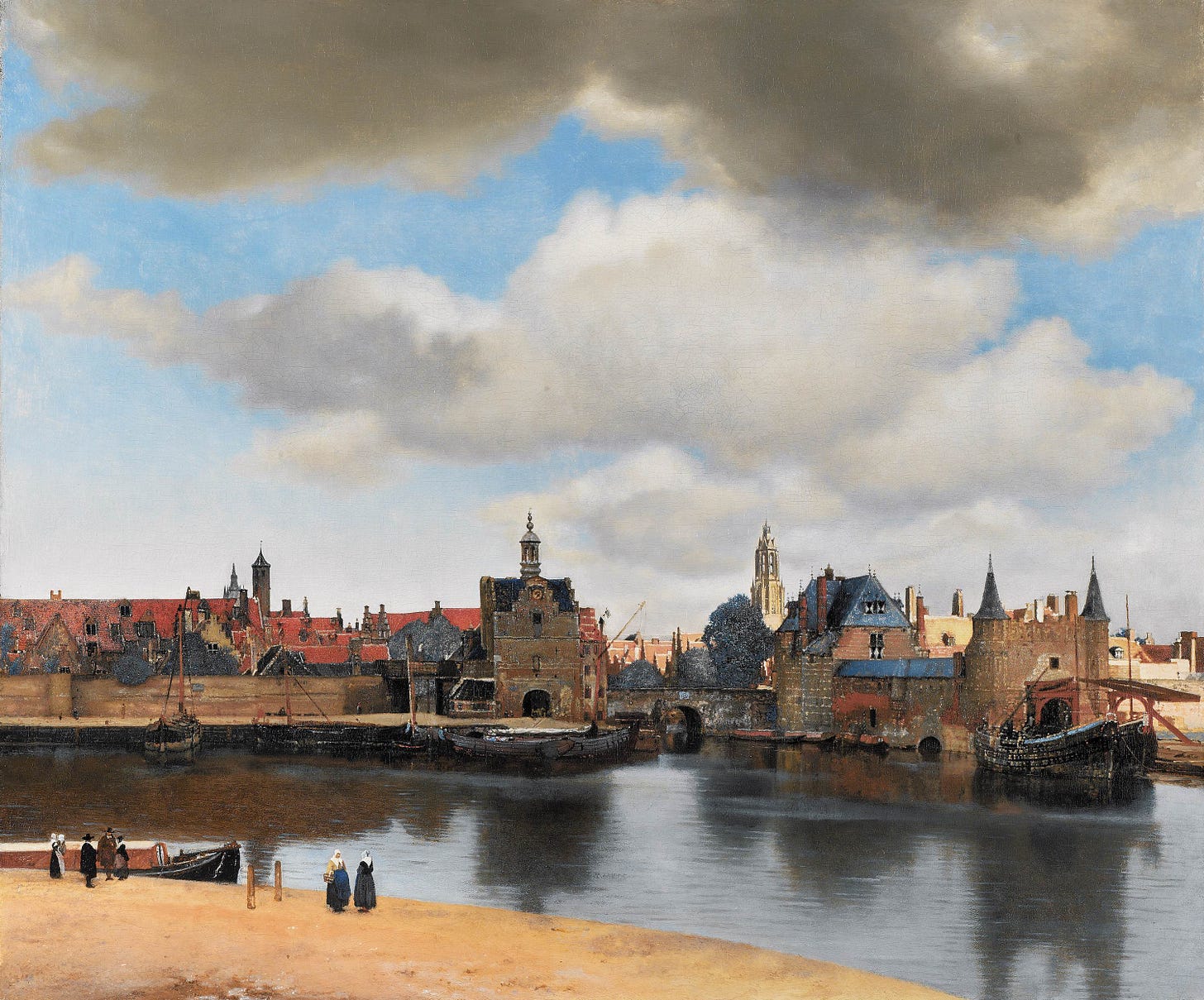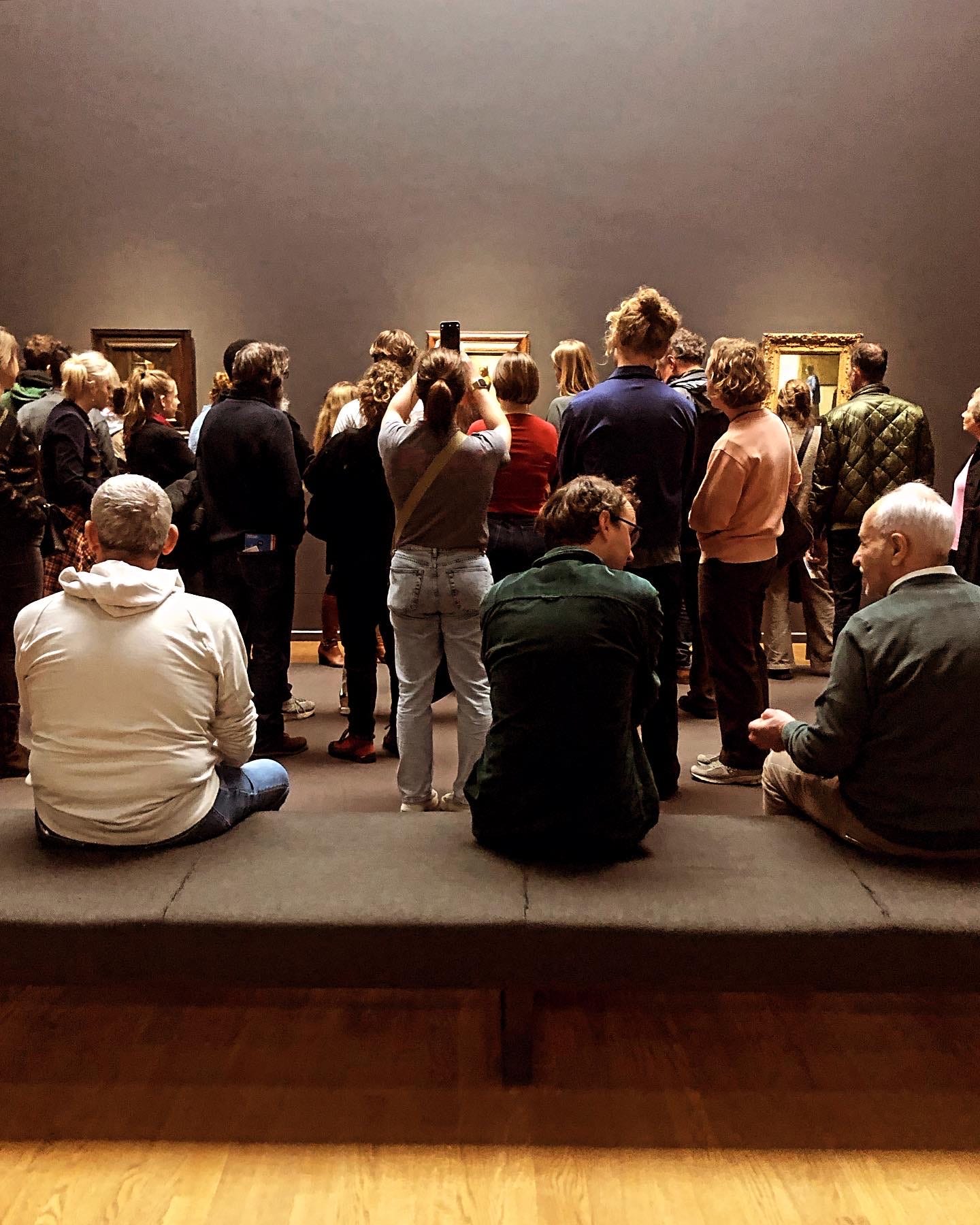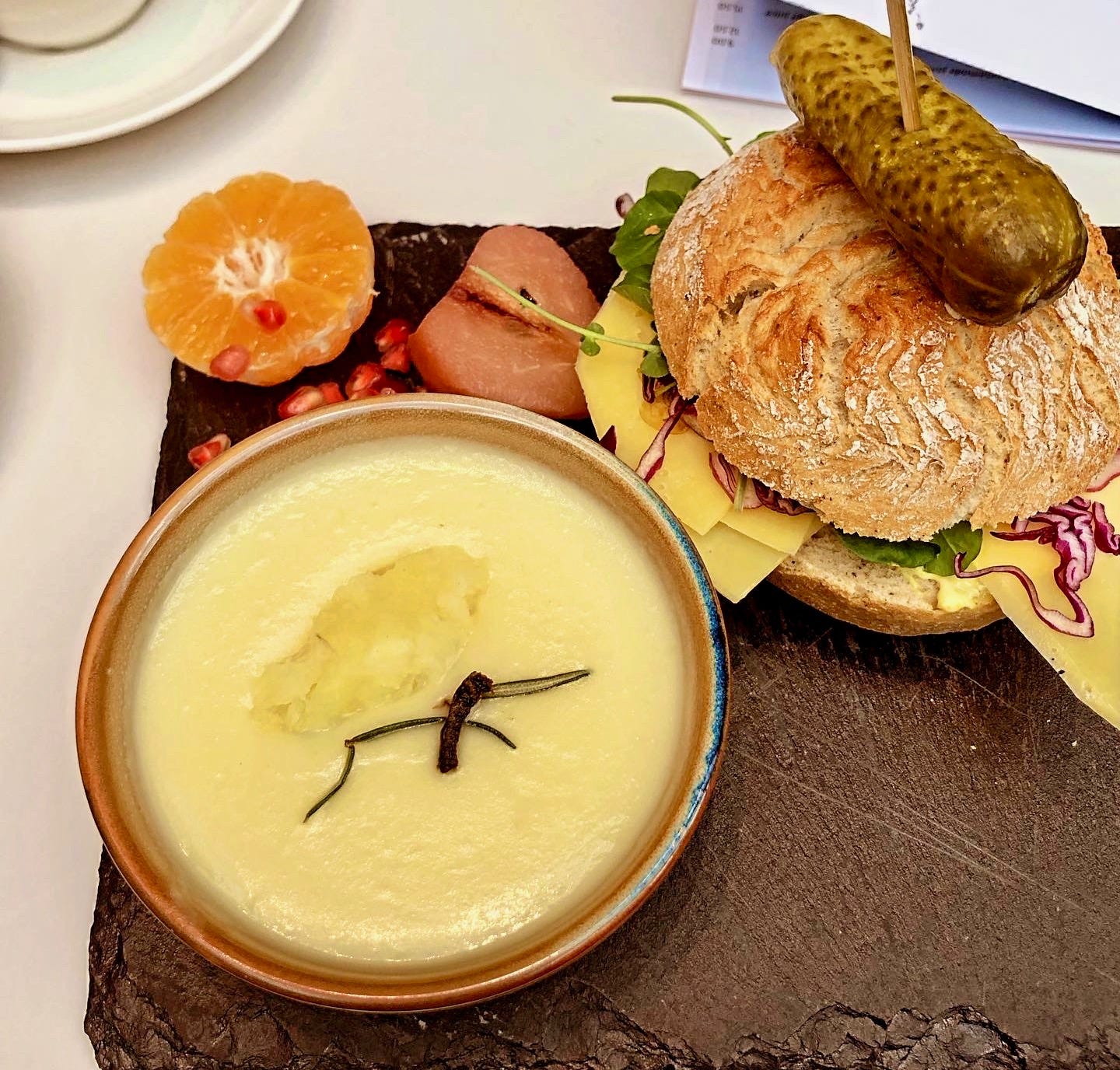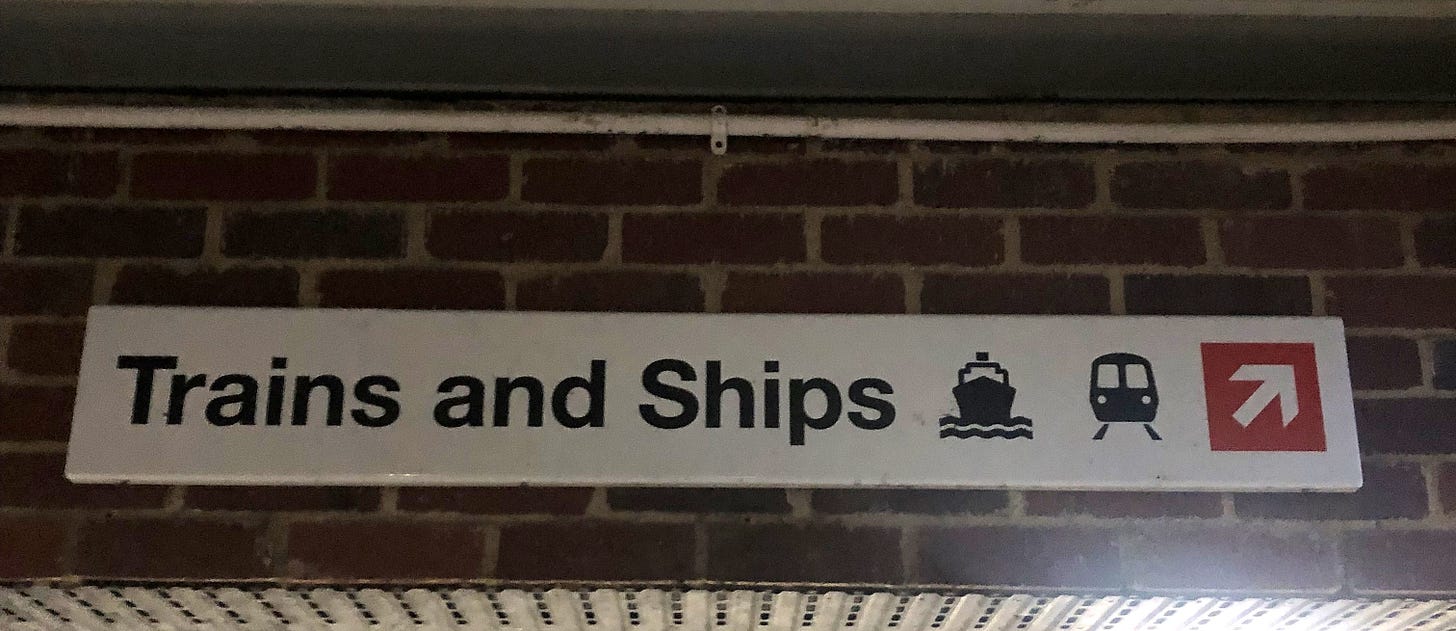Another way of looking
featuring Vermeer, Coorte, Cumming, and a vertiginous sense of mortality
I was going to write about feedback this week, but instead here’s a little diversion into thinking about art, and about looking at art:
Last weekend, propelled by the enthusiasm and insight of Laura Cumming’s Thunderclap, I took a ferry to the Netherlands and visited the Rijksmuseum in Amsterdam and the Mauritshuis in Den Haag. (If these Class Notes are forming an imaginary syllabus, then my imaginary syllabus definitely includes: Go places! See things! There’s more to life than books, you know!)
The image above, of other people looking at a painting you’re trying to look at, is a familiar one. It’s usually used to illustrate some sour-faced gripe about other people’s behaviour in art galleries, written by someone who doesn’t often have to queue. But look at this picture again. Look at all these people, gazing in wonder at a painting some of them have waited a long time or travelled a long way to come and see. Look at the gravity of their attention, the tilt of their heads, the way they are working out how to respond. Think about all the people they will talk about this to when they go away from here.
(Subtext here: what would it take to write a sentence that held so much attention in this way?)
Of course, there were some pictures that gathered this much attention because of their fame. There were some people who only glanced at the pictures long enough to tick them off, or to take pictures, or to frame a selfie. There were some people who didn’t look at the painting at all, but only at the version of the painting on the screen of their phone. This was surprising to me, but still I think represented an authentic hunger to be in the presence of art. (Also, a bonus: it turns out that if you wait approximately thirty seconds you get your turn to stand up close to the painting.)
And this hunger to be in the presence of art: what is it? What’s happening? This breathless wonder when confronted with art that hits in some way – why does it feel spiritual? Some of this is deliberately orchestrated, to be sure. The grand building, the entrance fee, the high ceilings, the guards, the low lighting and hushed voices; we’re only a couple of candles short of full cathedral vibes here. But it’s not just that. When I walked past the old Girl with a Pearl Earring – nice – and caught my first glimpse of A View of Delft, the physicality of my response took me by surprise. Reader, I gasped. I swayed and I swooned. I laughed in disbelief. And I looked, and I looked, and I looked. I looked at it from across the room, I looked at it from different angles, I swapped my usual specs for my reading specs and peered at it close up. And for most of the time I was muttering, prayerlike, what - the - actual - funk - ?
Look, I don’t know much about art. This is the first time I’ve been in an art museum for probably twenty years. I’m willing to concede that my reaction was naive or gauche or any of those things. But this painting convinced me of two things: that it was beautiful to look at, in ways I can’t quite articulate and which are not fully apparent in reproductions, and that the creation of it wholly surpasses my understanding.
When people talk about Dutch painting, they mostly talk about light. The way the light falls, the way the light shadows and illuminates, the way the light seems to spring from within the paint. Marcel Proust wrote that ‘the little patch of yellow wall’ was the key to this painting’s genius; the shine of early morning light in the distance, drawing us past the shadowed foreground into the heart of the picture.
(Pause here to consider: Marcel Proust standing here, in front of this painting. Remember that Van Gogh also stood here. Realise that anyone who has ever written about this painting has stood here and gazed. Always something of the holy relic about this stuff.)

From the little I know about art theory and art appreciation, I’ve gathered - perhaps unfairly? - the notion that we’re not really supposed to focus on technical accomplishment. That we shouldn’t ask how a thing was made, but why and to what end. But the intensity of my response to this painting was all about the how. I mean, just how was this achieved? When examined very closely, through reading specs, the uncanny detail of the brushwork is evident - delicate thin washes for the water, thick daubs for the woodwork of the ships, every brick and tile and spot of light delineated. The sheer labour involved is baffling. But, standing back, none of this laborious detail seems to add up to the overall effect that’s achieved; the light coming up on the morning, the sunlight on the distant rooftops, the cool morning hush. How does someone accomplish something like this, I kept thinking; I mean, what - the - actual - funk?
But what’s also so absorbing about this painting is that sense of the cool morning hush. Vermeer shifted some of the buildings around to create a balance in the composition, and added and removed the figures in the foreground until he had the effect he was looking for. This is the early morning of what looks likely to be a bright and clear day. The air is clean and fresh. The city is at peace, and all is apparently well. There is comfort in this image, and security. Delft in the 17th Century was a wealthy city, and many of its residents were comfortable and secure. That harbour was busy with the import of goods from across the Dutch empire; those substantial buildings were home to the financiers of that empire. This was a city whose comfort and wealth and security was built on slavery and exploitation. The paint that Vermeer used, that we’re looking at now, was made from materials brought back to Delft by those Dutch traders: lapis lazuli from Afghanistan, lead white, red ochre, madder, yellow ochre. Johan Maurits, who built the huis where this painting has hung for most of the last four hundred years, was personally involved in slavery and the slave trade, overseeing plantations in Brazil and taking an enormous fortune back to Den Haag.
None of which makes this painting any less beautiful, I don’t think. But sometimes peace and quiet has a context, doesn’t it?
This wasn’t the only painting I looked at while I was in the Netherlands. I was also struck by the still lifes of Adriaen Coorte, Pieter Claesz, and Clara Peeters, and by a question that my companion on this trip kept asking, which boiled down to a kind of ‘what’s the point?’
The portraits, the still lifes, the townscapes and landscapes; what actually is the point? Other than showing us what something looked like at that moment in history, what does it tell us? What’s the story? What’s the message?
(I’m bringing this all round to writing soon, I swear.)
I don’t know, I kind of feel like showing us what something looks like is point enough in itself. Here, this bread and this cheese on the table: look at it, see what I saw. Hundreds of years later, see what I saw. I was here, I was alive, I held things dear in my heart and I put them down to share with you.
That’s enough, isn’t it?
I don’t know if it qualifies as a message, or a meaning, or a narrative of sorts. It speaks to me, and mostly it speaks in a language beyond words.
But (here we are now) I think this is the question we can ask about our stories - what experiences are we trying to communicate? What experiences do we want our reader to have? What are we holding dear that we want to pass on along the line?
But also - and this is related, I think - what are we most focused on in our work? Vermeer, at some point, must have realised that both his interest and his gift lay in the depiction or the transmission of light; and so that became the focus of his intense dedication. What is it in your writing that you notice yourself dwelling on, or doing better at? For some writers that might be dialogue, for others it might be suspense, for others it might be comedy or tragedy or evocations of desire. A writer I greatly respect once told me that, “you know, Jon, when you describe things in your stories, that’s when I lean in a little closer.” And I was flattered, of course, but I was also intrigued. That hadn’t occurred to me before. I immediately went off and wrote Reservoir 13, which, to be honest, is just one damn description after another.
How do you know what that thing in your own writing is, that you might be focusing on without quite realising? What is it in your stories that makes a reader lean in that little bit closer? It can be hard to tell. And that brings me on to the question of feedback, which is what we’ll be looking at next week.
Class dismissed.
By the way, the overnight ferry is a great way to get to the Netherlands; it’s £50 each way, including the train from London. You pay extra for a cabin, but that’s cheaper than a night’s accommodation, and travelling overnight is basically a form of time-travel. 10/10, I definitely recommend.)
Homework:
A reminder that although these Class Notes have their origins in the teaching I do at the University of Nottingham, the lecture room is enormous and there’s plenty of room for you all. And that also goes for the exercises I sometimes suggest here; if you find yourself having a go, and you want to send me the results, go ahead. I’ll keep what you send me in confidence, and if I have a moment to send you some feedback I will. And/or if you have any questions you’d like me to address in future Class Notes, send them along.
Class dismissed.
p.s. think you could do my job?
The excellent people who run my department have given me research leave in the forthcoming Spring semester, which means they’re looking for someone to cover my teaching. Nottingham can be glorious in the Spring, and the students are a cracking bunch. Details here; closing date is Mon 4th Dec.





